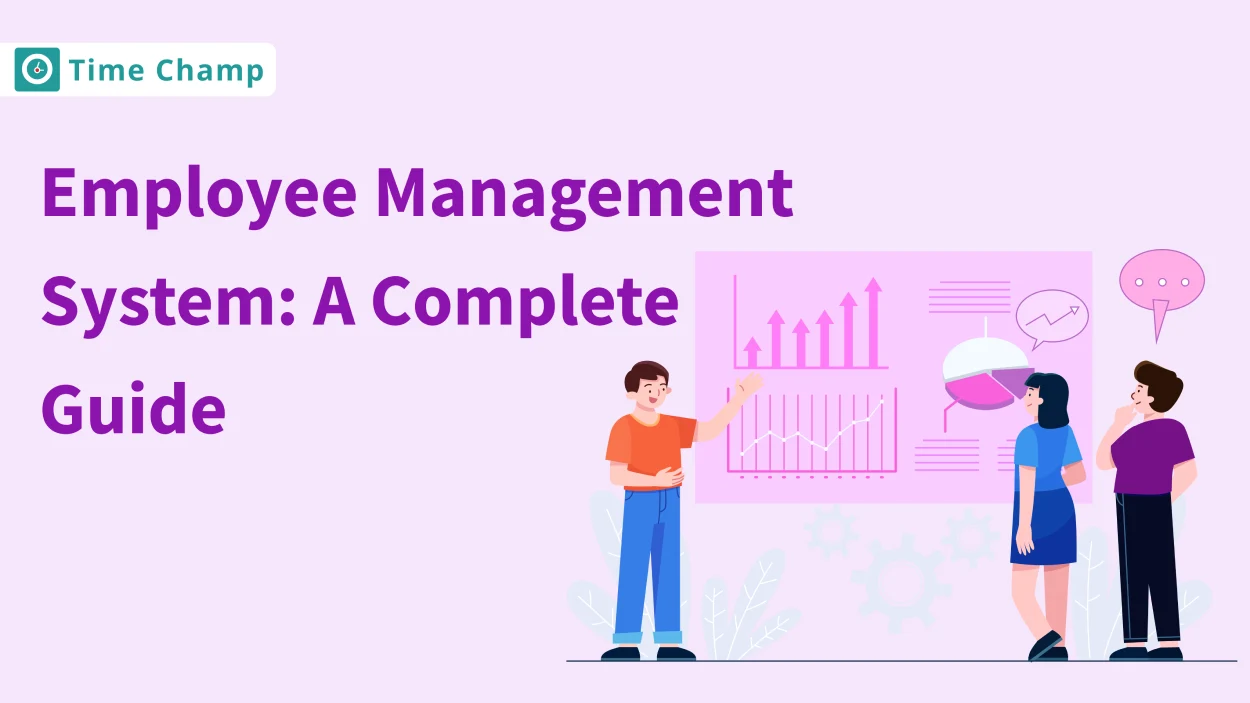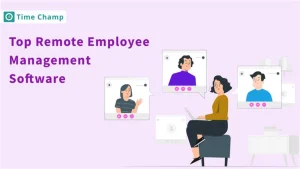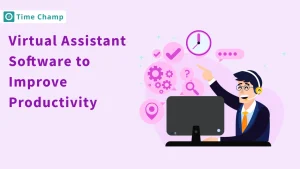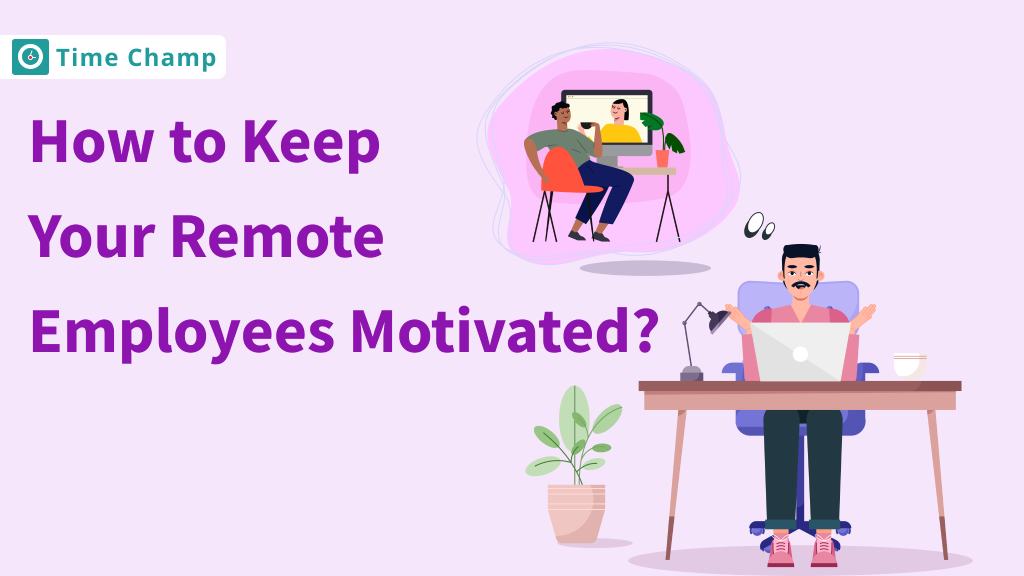Proper employee
management is
very important to any organization.
With the right tools, it can help
streamline operations, boost
productivity, and facilitate
smoother communication. An Employee
Management System covers all the HR
activities under one roof, such as
payroll, performance
tracking, and so
on.
In this blog, you will
learn what employee management is,
why workforce
management is
important, the benefits of
implementing an EMS, and several
types of systems. You will also
learn some of the best software
solutions to change the way you manage
your team.
Let’s dive in and see how the
right EMS can make a difference for
you and your business.
What is Employee Management?
Employee management is the process of hiring, training, and leading your team to work more efficiently and effectively toward the achievement of business goals. It includes tracking performance, fostering engagement, and creating a supportive work environment. Proper employee management increases productivity, elevates employee morale, and helps ensure that your business runs well by giving your employees the right equipment and guidance.
What is an Employee Management System?
An Employee Management System is software that allows you to manage, track, and optimize employee-related tasks. It centralizes everything from attendance and performance to payroll and leave requests, in one place. It streamlines processes, improves efficiency, and improves decision-making. No matter how big or small your team is, such systems are time saving and reduce manual errors, making workforce management easier and more effective.
Functions of an Employee Management System

1. Workforce Forecasting and Scheduling:
Effective Scheduling involves forecasting the number of employees required based on the workload. Employee management systems (EMS) assist by tracking which activities are productive or not, then allowing managers to assign tasks wisely. EMS ensures that employees spend their time efficiently by marking certain apps or websites as productive or unproductive, so the company can achieve its goals and increase productivity.
2. Payroll Administration:
Payroll administration refers to the procedures that are involved in dealing with the financial aspects of employees’ salaries, tax deductions, bonuses and record keeping. It automates the salary calculation, so that employees are paid right and on time. It also simplifies compliance with tax regulations by generating tax reports and deductions automatically, thereby minimizing errors and penalties. Automated payroll saves you a lot of time and lets you focus on growing your business instead of being stuck in manual calculations.
3. Attendance Tracking:
An employee management system automatically records the time when employees clock in and clock out. The employee management system keeps track of hours worked, manages shifts, handles time off requests, and also monitors absence. The system ensures constant and accurate attendance records, which can be used for payroll processing and compliance reporting.
4. Talent Management and Succession Planning:
Talent management guarantees that you have trained employees to be the next leaders. Employee management applications indirectly support this domain by offering commentary on employee productivity, which is a leading indicator of potential talent in succession planning based on performance data.
5. Learning and Development Programs:
For effective development, it is important to track employee training progress and to find skill gaps. With EMS tools, organizations can mark certain educational apps and websites as productive, enabling them to include self-learning and training activities as part of the employees’ productive hours. This feature can assist HR in incorporating learning and development as part of the overall productivity strategy.
6. Compliance with Labour Laws and Regulations:
Compliance
includes adhering to work hours,
rest periods, and record-keeping as
required by labor laws. Although EMS
itself may not manage compliance
directly, its detailed time-tracking
can ensure that employees’ work
hours are documented accurately,
supporting compliance with labor
regulations.
By using an EMS,
businesses can gain a market
advantage, reduce the margin for
human error and enable their teams
to fully benefit from enhanced
working environments. Now
let’s see about the importance
of an employee management system.
Importance of Employee Management
Employee management is vital for any business that aims to maintain a competitive edge and achieve long-term success. Here are the key reasons why effective employee management is essential:
- Fosters a Positive Workplace Culture: Effective management contributes to a work environment where employees feel valued and recognized. A positive culture boosts morale and reduces turnover rates.
- Aids in Employee Development: Managing your employees means investing in their growth through training and development, which can lead to innovation and keep the company competitive.
- Improves Employee Retention: Good management includes providing career paths and development opportunities, which are critical factors for retaining top talent.
- Ensures Legal Compliance: Employee management helps businesses adhere to employment laws and regulations, thereby avoiding legal issues and maintaining a company’s reputation.
- Drives Better Decision-Making: With solid employee management practices, leaders have access to accurate data and insights that inform strategic decisions and policy-making.
- Increases Adaptability: Organizations that manage their employees effectively can better adapt to market changes and evolving business needs.
- Enhances Team Collaboration: Clear management structures and communication strategies can improve teamwork and ensure that employees collaborate effectively towards common goals.
- Improves Customer Satisfaction: Happy and well-managed employees are more likely to provide excellent customer service, leading to a better customer experience and loyalty.
- Optimizes Resource Allocation: Employee management systems help in planning and aligning staff to the strategic needs of the business, ensuring that the right resources are available at the right time.
Benefits of Implementing an Employee Management System
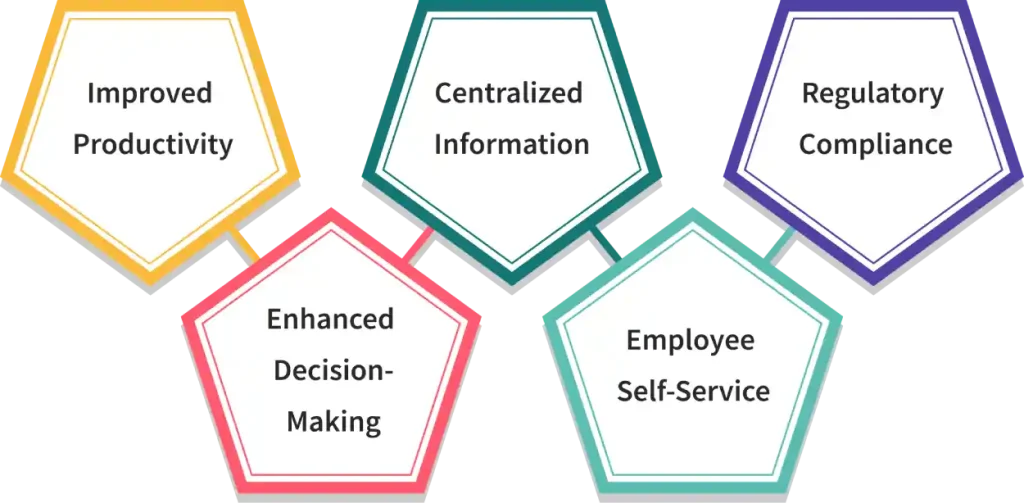
There are a wide variety of benefits associated with the several dimensions of the employee management system. Some of the most impactful employee management system advantages include:
1. Improved Productivity:
With an EMS, routine tasks like attendance tracking, leave management and payroll processing can be automated. It reduces manual errors, saves time, and lets employees spend more time doing more strategic work. Then, HR people can focus on strategic endeavors like employee engagement and development, which drives motivation and performance. EMS streamlines processes, so that employees can spend their time efficiently, and overall productivity improves.
2. Enhanced Decision-Making:
EMS provides real-time data, analytics, and comprehensive reporting tools that provide managers with valuable insights into their workforce. Performance tracking, attendance records, and leave management features help managers to identify trends, address challenges, and plan effectively. Access to accurate and up to date information is critical for making timely decisions whether it’s workforce planning, performance reviews or talent management.
3. Centralized Information:
An EMS is a central repository of information pertaining to the employees. This not only simplifies data management but also guarantees that correct and homogeneous information is at hand. This decentralized approach allows the company to function smoothly and ensures that different legal regulations are implemented.
4. Employee Self-Service:
Many modern EMS platforms offer self-service features for employees. This allows them to independently manage aspects like updating personal information, submitting leave requests, and accessing relevant documents. Empowering employees with self-service options not only improves efficiency but also enhances employee satisfaction.
5. Regulatory Compliance:
Keeping up with labor laws and regulations can be complex. An EMS often includes automated compliance features that help organizations stay in line with legal requirements. This can involve managing work hours, ensuring proper documentation, and implementing policies to adhere to labor laws.
Types of Employee Management Systems
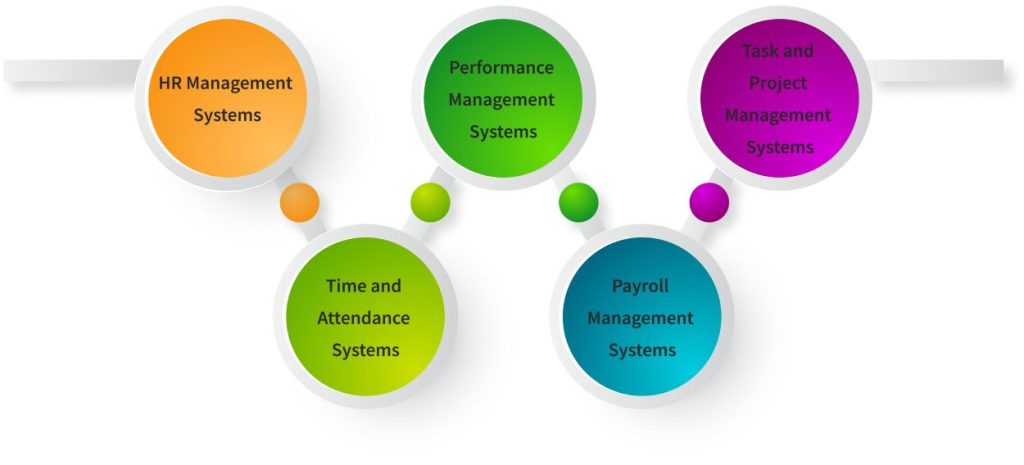
1. HR Management Systems (HRMS)
An HRMS is a tool that brings all your HR tasks together in one place such as managing employee details, payroll, benefits, and onboarding. It reduces mistakes by automating tasks, ensures you follow the rules and makes repetitive work easier. This system helps you keep employee information well organized and saves time so you can spend more time engaging your team and making smarter decisions for your business.
2. Time and Attendance Systems
Time and attendance systems are tools that help you track employee working hours, manage leave, and organize schedules easily. They eliminate mistakes by automating tasks like timesheet management and ensuring payroll accuracy. These systems help you to encourage punctuality, keep your workforce organized, and give you better control over employee availability and productivity.
3. Performance Management Systems
Performance management systems are tools that allow you to measure how employees are performing by setting goals, monitoring progress, and providing continuous feedback. They help you to be accountable, and keep your employees motivated and aligned with your company’s goals. They increase productivity and make it easier to identify and reward your top performers.
4. Payroll Management Systems
Payroll management systems are tools that automatically handle salary payments, tax deductions, and direct deposits. They reduce mistakes, save time and make sure employees get paid correctly and on time. These systems also help you follow tax rules and make you confident about your financial processes.
5. Task and Project Management Systems
Task and project management systems allow you to assign tasks, set deadlines and track progress in real time. They make sure that the project runs smoothly, with transparency and without delay. They keep your team organized, aligned, and focused on accomplishing business goals in an efficient way.
Top 5 Employee Management Software
1. BambooHR
BambooHR is an employee management software that helps you streamline your HR processes. A clean and intuitive interface makes it easier to manage employee data, payroll, and hiring. Time-off tracking and onboarding support saves you time on repetitive tasks and allows you to focus on building a better team. It also gives you powerful reporting to help you make smarter decisions. BambooHR is worth a look if efficiency and organization are your goals.
2. Time Champ
Time Champ is comprehensive employee management software built to simplify how you run and optimize your team. It provides features such as real-time activity monitoring, in-detail productivity reporting, attendance and workflow monitoring tools. With tools like website and app controls, USB blocking, and screen recordings, you have a complete view of everything happening on a day-to-day basis. By helping you identify inefficiencies, boost accountability, and streamline processes, Time Champ ensures you can manage your team effectively and drive your business toward success.
3 Monday.com
Monday.com is a versatile employee management software that makes team collaboration and task tracking easy. It makes project management, employee scheduling and resource allocation easier. Its user friendly interface allows you to create workflows that fit your team’s needs, increasing productivity and communication. Monday.com will enable you to get a better picture of how your team is performing and how your projects are progressing, making it easier to manage your workforce.
4. Gusto
Gusto is an employee management software that makes HR tasks like payroll, benefits, and compliance easier. Onboarding, managing employee records, and running payroll is smooth and easy. Gusto automates tax calculations, provides detailed reports, and handles benefits administration so you can save time and reduce errors. With its intuitive platform, your team stays compliant and supported, while you focus on growing your business. With Gusto, you’ll have more control over HR tasks and can manage your workforce more efficiently.
5. Workday
Workday is an employee management tool that offers a wide range of HR management solutions, including talent acquisition, workforce planning, payroll, and performance management. It provides intuitive interfaces and advanced analytics to streamline HR processes, improve decision-making, and improve employee experiences. In one platform you can automate key HR tasks, track performance, and ensure compliance. Workday helps you see deeper into your workforce, enabling you to better manage and develop your team. It can save you time and keep your organization on track with its goals.
Transforming Work with the Best Employee Management Tool
Organizations always seek an efficient employee management system that fits their operation needs. There is a myriad of employee management programs, which range from enterprise systems to niche tools aimed at specific HR practices.
Time Champ: An Advanced Employee Management Software
An innovative employee management platform that is highly recognized for its comprehensive suite of features and ability to integrate with other HR processes. Time Champ’s features includes but not limited to:
1. Attendance Management and Timesheets:
Time Champ makes it simple to track the employee attendance and manage timesheets. Real time tracking allows you to easily track when employees clock in and clock out so you know accurate records for payroll and productivity analysis. It also records idle time, so you can see when employees are not working and then address any issues. It automates timesheet calculations, saves time, and reduces errors. Attendance patterns can also be monitored to identify problems such as tardiness or absenteeism. This streamlined process lets you concentrate on growing your business while ensuring compliance and transparency.
2. Task Tracking:
Time Champ provides a task tracker agent to monitor employee systems for flexible and accurate work activity tracking. It features functionalities like ‘start task’, ‘stop task’, ‘Auto finish task EOD’, and ‘Auto start beginning task of the day’. The task tracking feature automates the monitoring of tasks, capturing all relevant data and simplifying the management of employee work items. It eliminates the need for manual timesheet entries and supports efficient invoice generation for clients.
3. Employee Productivity Reports and Analysis:
With Time Champ, you get detailed employee productivity reports and analysis to make informed decisions. The software keeps track of key performance metrics such as active work hours, idle time and task completion rates and shows you how productive each employee is. It’s easy to see who is a top performer and who may need some help or extra training. These insights will help you improve team performance, streamline workflows, and generally improve your business efficiency so you can focus on what matters most for your company’s growth.
4. Activity Tracking:
Time Champ allows you to effortlessly track employee activity in real time, so you can see exactly how your team is spending their work hours. You’ll get insights from app usage to websites they visit to see how productive your employees are. This helps you identify inefficiencies, streamline workflows, and make sure your team is working on the right things. Activity tracking allows you to make data driven decisions to improve performance and reach business goals.
5. Time Tracking:
Time Champ allows you to track employee work hours in real time and keep an accurate record of them. It simplifies monitoring productivity and makes sure that time is spent in the right way. Accurate tracking of time helps you identify areas for improvement, manage overtime, and even optimize resource allocation. It also makes payroll processing smoother and ensures that the company complies with company policies and labor laws. Time Champ’s simple, intuitive interface makes tracking easy and accessible, saving you time and making your team more efficient.
Employee Management Software vs. Traditional Approaches
Traditional HRM techniques vs employee management software is still an ongoing discussion. Traditional approaches depend on manual processes and paper methods while modern employee management solutions use technological methods of computerizing and simplifying work processes. The contrast is clear: The use of software solutions is far more efficient, accurate, and data secure than manual methods could ever be.
HR management is not easy. One cannot always keep tabs on employees and their problems simultaneously. The HR should take care of the overall development of the company as well as that of the employees. Employee management applications have taken on a new level of sophistication with real-time analytics and mobile access capabilities.
Selecting a Suitable Employee Management System for your Business.
Selecting the appropriate employee management system can be cumbersome. Nonetheless, through a systematic process, you can identify the system that suits your expectations. Here are the steps to guide you through the selection process.
-
Define your needs: Before selecting an employee management system, you need to know what your business needs. Consider tasks such as tracking attendance, payroll, performance, and communication. Knowing these requirements will help you to narrow down the options that will work for your business structure and goals.
-
Research and compare: Research and compare different employee management systems. Check out features, pricing and reviews. It should also have a user friendly interface and match your business needs. It will help you make a more informed decision by comparing a few options.
-
Request demos and trials: Don’t just rely on online descriptions. See the system in action by requesting demos and trials. This lets you test its functionality, user interface, and determine how well it works with your team. This will also help you find out any gaps before you commit.
Take a demo of Time Champ to experience its features and see how it can boost your team’s productivity.
-
Check for scalability: Make sure the system can scale with your business. The system should scale up without breaking, whether you’re planning to hire more employees or expand to new locations. Find out how the vendor will handle growth and if it has features that will help you in the future.
-
Consider vendor support and training: When you’re adopting new software, strong vendor support is crucial. See if the vendor provides 24/7 support, training resources, and ongoing assistance. Access to reliable support means that implementation is smoother and downtime is less.
If you go through these steps, you will be able to pick a suitable employee management software that is relevant at the moment and in the future.
Make your employee management better with the advanced features of Time Champ.
Use Time Champ to optimize your employee management and boost team productivity with the most effective system
Employee Management Systems and Security Considerations.
When choosing an employee management
system (EMS), it’s important to
protect employee data. To prevent
data breaches and to be compliant
with regulations such as GDPR and
HIPAA, companies must choose systems
with strong security features. Data
security is prioritized to protect
confidential information and to keep
employees trust.
A good
employee management tool will
utilize modern cryptography, secure
data retention, and continuous
security checking to prevent
unsanctioned manipulation of
confidential information. In terms
of sound EMS, regular security
audits and compliance checks are
also very important.
Ensure
that your EMS provider has
role-based access controls in place
to ensure that only the right people
can see or edit sensitive employee
data. And it’s also important to
train your team on data security
practices, because even the best
system can fail without proper use.
With secure tools and training your
team, you can build a safer and more
reliable way to manage employee
information.
Optimize your team management and boost productivity with Time Champ’s advanced Employee Management System!
Signup for FreeBook DemoConclusion
To sum it all up, the right employee management system makes HR tasks easier, increases productivity, and fosters a better work environment. The EMS automates tasks, facilitates smarter decisions based on real-time data, and allows you to be compliant with laws. From managing payrolls to tracking performance to supporting employee growth, it brings everything together for you to manage your team more effectively. The right system leads to happier employees and better business results.
Frequently Asked Questions
The key purpose of an employee management system is to streamline and centralize the process of managing workforce information, optimizing HR tasks, and enhancing decision-making regarding employee management.
EMS contributes to employee satisfaction by providing employee self-service options, streamlined communication, and regular feedback, all of which can lead to a more engaging and transparent workplace.

